For 35-year-old Swiss-born Corinne Weidmann—who artistically goes by Iuna Tinta—the landscapes of home exude creative inspiration. Part of her family is from the Bernese Oberland, so images of Lauterbrunnen and the surrounding mountains and glaciers make frequent appearances on her canvas. But desire for world travel has taken her to the jungle of Costa Rica, the windswept shores of the Pacific Northwest and, now, to where she resides in Berlin. But even at the far reaches of the globe, the mountains of her home permeate her work and imagination. We caught up with her to learn more about her unique view of layers in the landscape and how she attempts to depict natural places over time.
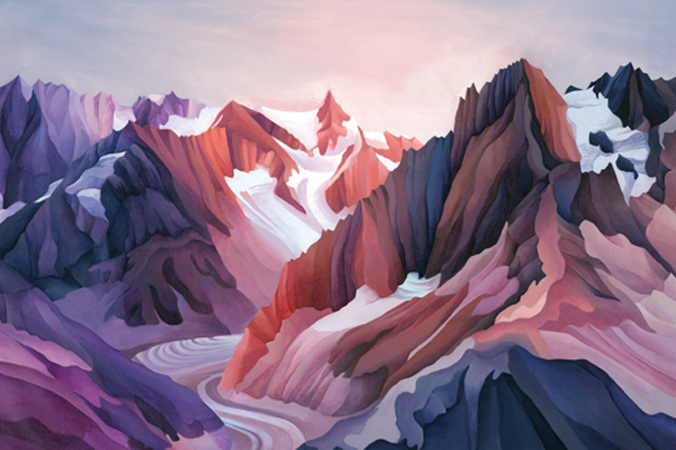
Image Title: Mer de Glace
Backcountry Magazine: What go you interested in painting mountain landscapes?
Corinne Weidmann: It wasn’t until I left Switzerland that I started to paint mountains in a way where I actually focused on them. It seems as though mountains cover two-thirds of the country, but they’re not just everywhere physically, they are also omnipresent in the culture. You see them on TV, in commercials; they’re everywhere. And while I love skiing and snowboarding and have been in the mountains very often, I never thought that I would paint them. I have been living abroad for about 10 years now, and after I left, I started working with mountains.
The first time I painted the mountains was when I was living in the jungle of Costa Rica, which is kind of funny. I was there for a long time, and if you’re abroad for a long time, you start to reflect on your home and on your cultural background. It transformed everything, so now when I go home I see mountains in a completely different way. I started to pay more attention to the lines, the glaciers, the ice and what they actually look like, especially because they are on such a massive scale.

Image Title: Galmigletscher / Fieschergletscher
BCM: How has being an artist changed how you see the mountains?
CW: I don’t think I take them for granted anymore. I always appreciated the landscape growing up, but my interest in them has started to change. I’m interested in geology and glaciology, and I started to collaborate with scientists.
BCM: When did you decide to focus on art as a profession?
CW: I’ve always been into painting and crafts. I never really thought about being a professional artist, because it sounded so foreign—and like a parent’s nightmare. My parents were always very supportive of me, but people tend to be shocked when you tell them you’re going to paint for a living. They don’t think it’s possible.
Initially I studied graphic design but was always more interested in the illustration side of art. Over the years, I was able to make the transition to being a full-time painter. Although I still work digitally in Photoshop sometimes, most of my work is hand drawn—even the graphics for the snowboards.
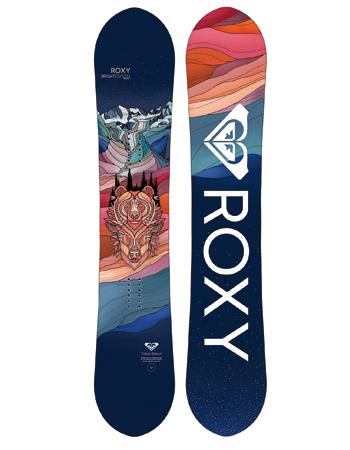
Image Title: Roxy Spirit Animal
BCM: You have done a number of collaborations with companies. How do you change your style when you are working with someone else versus working for yourself?
CW: If I work for myself it can be very experimental, and it doesn’t need to turn out well—that’s the major difference. Working with companies is very interesting as you design back and forth and work in a team. You get fresh input and people come up with individual ideas you might not have thought of before. This can give your work new tweaks and is inspiring.
BCM: What was the first thing you collaborated on, and how did that opportunity arise?
CW: The first thing I collaborated on was a snowboard for Roxy, and that was right after I decided to be self-employed. I wanted to make my dream of being a professional artist a reality, so I put all my energy into it and packed up my backpack and moved to Vancouver. I lived in the Pacific Northwest for a while, and that’s where I met people and things started to happen.
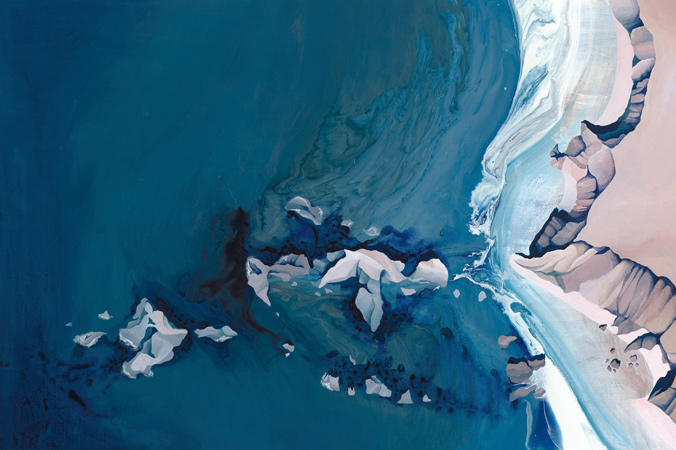
Image Title: Oregon Coast
BCM: What does your artistic process look like?
CW: When I paint a certain mountain range, of course, I like to go to this specific area and take photos or walk around and get a feel for the place. I’ll do sketches, but I don’t really paint outside. I like to enjoy the landscape and soak it all up. Back in my studio where I have the space and the time to properly develop things, I would use my memories, the sketches and photographs as references.
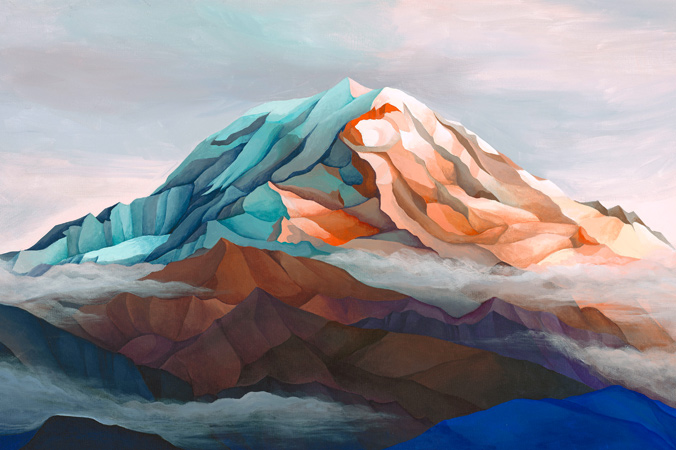
Image Title: Mt. Rainier
BCM: What inspired your jungle pieces?
CW: I finished my studies and went traveling. The initial idea was to go away for three months, but I ended up in the very first village I went to in Costa Rica and stayed there for two years. I lived on the Pacific side on the Nicoya Peninsula, where I was working in a surf camp. The simple life gave me time to reflect and to contemplate about values and goals. It made me grow into a certain direction, and, therefore, the time in Costa Rica was a very important period for me. The jungle pieces are all about growth and blossoming.
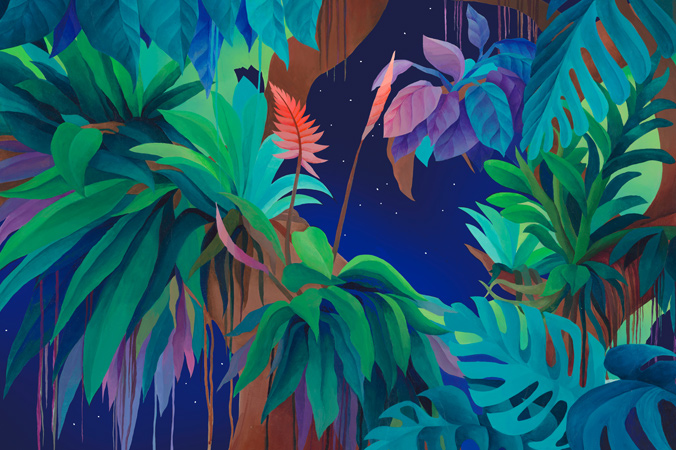
Image Title: Epiphyte Jungle
BCM: What’s your favorite place to paint?
CW: I specifically love to paint the Lauterbrunnen valley near my home in Switzerland, but the entire region between Bern and Wallis is full of amazing peaks and glaciers. The high alpine area around the Aletsch glacier is breathtakingly beautiful. There’s nothing growing up there, and it’s a lot like being on another planet.
One year ago, I started working with scientists in a students program called “Girls on Ice.” The program is about exploring and learning about glaciers and the alpine landscape in which the expedition is based. The students conduct scientific field studies with a team of professional glaciologists, ecologists, mountain guides and artists.
As an artist, you have the tendency to see the beauty of the landscape and it’s magnitude, while a geomorphologist sees the landscape entirely different. It’s these different perspectives that instantly caught my attention. So one scientist and I have started to collaborate in order to develop paintings in which we would try to change colors to challenge people’s perceptions of what they’re looking at. This is all in an early stage, so we’ll see how this works out.
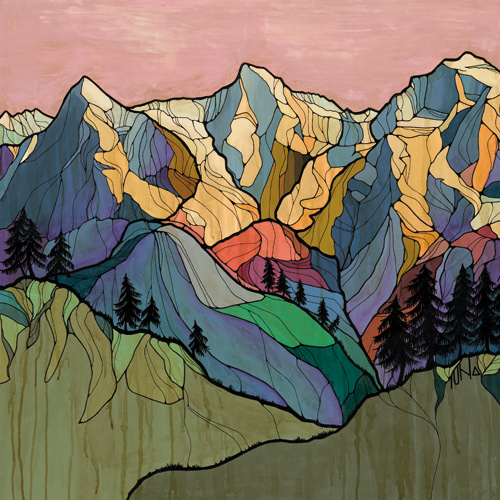
Image Title: Eiger, Mönch und Jungfrau
My work is a way of finding structure, reasoning and pattern in such a massive thing—the landscape. I put it together piece by piece, shape by shape. Another collaborative project is about layers and how there is different information in each layer of the glacier. Each year the snow cover turns into ice, so each layer documents the past. It is a little like the pages of a book. It also depicts the passage of time, which is a really important factor in topics like climate change, because people can’t really grasp what happens because of the massive scale, so I like trying to capture that.
—
To view more of her artwork, visit iunatinta.com.










Related posts:
Skintrack Sketches: B.C.’s former freeride competitor Richard Small on art, mixology and his native …
Skintrack Sketches: Artist Nikki Frumkin blurs the lines of art and adventure
Skintrack Sketches: Freeskier Chris Benchetler tops things off with graphic design
Skintrack Sketches: Mimi Kvinge looks to balance authentic artistic identity and brand